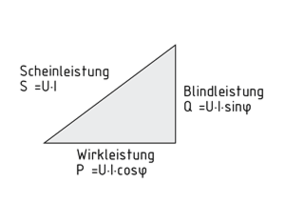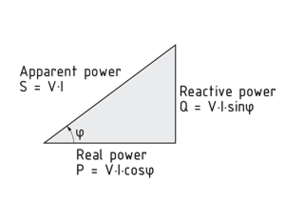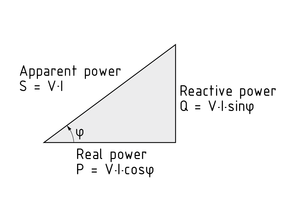
Seleccione uno
o más idiomas
0,1,3
- Alemán
- Inglés
- Chino
- Español
Potencia aparente

La potencia aparente especifica la potencia eléctrica suministrada en una carga. Para distinguirla de la potencia real, el valor se especifica en voltiamperios (VA).
En los circuitos de corriente directa y en los de corriente alterna sin inductancia o capacitancia, la potencia aparente es igual a la potencia real. Si ocurren pérdidas de potencia reactiva en una carga (por ejemplo, un motor eléctrico), la potencia de entrada ya no concordará con la potencia consumida por la máquina. La potencia aparente puede desglosarse en potencia real y potencia reactiva. La relación entre estos tres valores se ilustra claramente en el triángulo de potencia. La potencia aparente es el producto de la corriente y el voltaje, mientras que los valores de la potencia reactiva y aparente resultan del ángulo de cambio de fase $\varphi$. En términos generales, el valor de $\varphi$ debe mantenerse tan bajo como sea posible de manera que se convierta tanta potencia aparente como sea posible en potencia real.
Triángulo de potencia para corriente alterna
Scheinleistung

Die Scheinleistung gibt die an einen Verbraucher zugeführte elektrische Leistung an. Sie wird auch häufig als Anschlussleistung bezeichnet. Zur Unterscheidung von der Wirkleistung erfolgt die Angabe von Scheinleistung und Anschlussleistung in Voltampere (VA).
In Gleichstromkreisen oder Wechselstromkreisen ohne Induktivitäten oder Kapazitäten entspricht die Scheinleistung der Wirkleistung. Entstehen in einem Verbraucher (z. B. Elektromotor) Blindleistungsverluste, so entspricht die aufgenommene Leistung nicht mehr der in der Maschine umgesetzten Leistung. Die Anschlussleistung teilt sich auf in Wirkleistung und Blindleistung.. Die Beziehungen dieser drei Werte untereinander können anschaulich im Leistungsdreieck dargestellt werden. Die Scheinleistung entspricht dem Produkt aus Strom und Spannung, die Blind- und Wirkleistungen ergeben sich aus dem Phasenverschiebungswinkel$\varphi $. Grundsätzlich ist ein möglichst kleiner Wert von $\varphi $ anzustreben, sodass ein möglichst großer Betrag der Scheinleistung als Wirkleistung umgesetzt wird.
Apparent power

Apparent Power specifies the electrical power supplied to a load. To distinguish it from Real power, the value is specified in volt-amperes (VA).
In Direct current circuits and alternating current circuits without Inductance or Capacitance, the apparent power is equal to the real power. If Reactive power losses occur in a load (e.g. electric motor), the power input no longer matches the power consumed by the machine. Apparent power can be broken down into real power and reactive power. The relationships between these three values are clearly illustrated in the power triangle. The apparent power is the product of the current and voltage, while the reactive and apparent power values result from the phase shift angle$\varphi$. Generally speaking, the value of $\varphi$ should be kept as low as possible so that as much of the apparent power as possible is converted to real power.
视在功率

视在功率是指供给一个负载的电功率。与有效功率不同,其值单位用伏安 (VA) 来表示。
在直流电路和没有电感或电容的交流电路中,视在功率等于有效功率。如果负载发生无功功率损耗(例如电动机),电源输入不再匹配机器消耗的功率。视在功率可以分解成有效功率和无功功率。这三个值之间的关系可以通过功率三角形清楚地表示。视在功率是电流和电压的衍生值,而无功功率值和视在功率值可以通过相移角 $\varphi$ 计算。一般而言, $\varphi$ 的值要尽可能的小,这样视在功率才能尽可能多的转换为有效功率。
交流电的功率三角形
近义词
连接的负载
已安装的负荷
